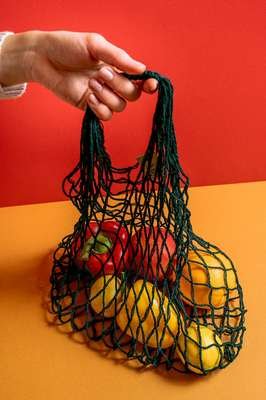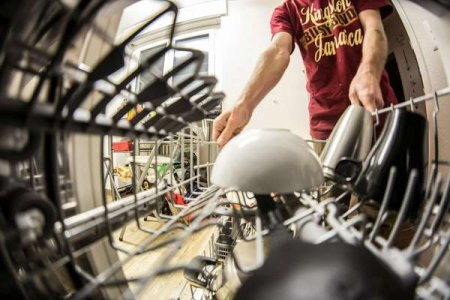Stop Risking Your Health! Why This Popular Social Media Hack for Cleaning Produce Is a Dangerous Mistake
By
Veronica E.
- Replies 0
In the age of social media, where life hacks and do-it-yourself (DIY) tips spread quickly, it's easy to get caught up in the excitement of finding new ways to simplify our daily routines.
But not everything you see on social media is as great as it seems, especially when it comes to a recent trend suggesting a questionable method for cleaning your produce.
Here at The GrayVine, we’re all about making life easier for our over-60s community, but we also prioritize your health and safety.
Let’s break down why this hack is a recipe for disaster and what you should do instead to keep your fruits and veggies safe and clean.

The Dishwasher Debacle: A Viral Misstep
The video in question, posted by @larad_official, shows an enthusiastic attempt to streamline the cleaning process of produce by using a dishwasher.
While the idea might seem innovative at first, it’s fraught with problems. Food safety experts are raising serious concerns, urging viewers to avoid this misguided method.
Dr. Kimberly Baker, director of the Food Systems and Safety Program Team at Clemson University, reacts with a resounding plea: “Oh my God, don’t do it — please, don’t.”
The reason for her concern lies in the journey our produce takes from farm to table.
Source: TikTok / larad_official
Despite cleaning processes along the way, fruits and vegetables are still exposed to numerous contaminants, including yeasts, molds, and pathogens that can cause foodborne illnesses.
The Dishwasher’s Dirty Secrets
Matthew Taylor, a food safety expert and global senior manager of food consulting at NSF, highlights the inherent risks of using a dishwasher for cleaning produce.
The appliance is designed for dishes, not delicate edibles, and is often coated with chemical residues from detergents and rinse aids.
Not to mention, the filter at the bottom of the dishwasher, which can harbor remnants of previous meals, is rarely cleaned after every use.

Even if you’re diligent about cleaning your dishwasher, a small pool of water that remains at the bottom can still contaminate your produce.
Adding vinegar to the mix, as suggested in the video, won’t sanitize effectively. In fact, it could leave you with unintentionally pickled produce due to the extended contact time required for vinegar to kill pathogens.
Warm water temperatures in the dishwasher can also degrade the quality of your produce and create a cozy environment for pathogens to thrive.
“Pathogens are not much different than us human beings,” Dr. Baker explains. “We like to be warm... We like moisture. We like food. All those things are what pathogens need to grow on, as well.”
The Safe and Simple Solution
The best way to clean your fruits and veggies is to stick with the tried-and-true method: rinsing them under cool running water from the tap.
This straightforward approach effectively dislodges and removes contaminants. For those hard-to-clean items with nooks and crannies, a dedicated produce brush can be used to gently scrub the surfaces.
Running water is essential, as washing produce in a sink full of water can spread contaminants rather than eliminate them.
While commercially available produce washes might seem like a good idea, their safety and effectiveness are not well-established, according to the U.S. Food and Drug Administration.

In Conclusion: Trust the Experts, Not the Trends
While social media can certainly offer a fun escape and even provide some helpful tips, it’s important to approach everything you see with a healthy dose of skepticism.
Not all advice shared online is grounded in expert knowledge or proven safety.
When it comes to food safety, there should be no compromise. Expert advice and well-established practices should always take precedence over trendy methods that may not be as reliable or safe.

Here at The GrayVine, we encourage our readers to share their thoughts and experiences. Have you come across any food safety hacks that you’re unsure about? Do you have any tried-and-true methods for keeping your produce clean? Join the conversation in the comments below!
But not everything you see on social media is as great as it seems, especially when it comes to a recent trend suggesting a questionable method for cleaning your produce.
Here at The GrayVine, we’re all about making life easier for our over-60s community, but we also prioritize your health and safety.
Let’s break down why this hack is a recipe for disaster and what you should do instead to keep your fruits and veggies safe and clean.

Fresh produce deserves the right care—learn how to clean it properly! Image Source: Pexels / Antoni Shkraba.
The Dishwasher Debacle: A Viral Misstep
The video in question, posted by @larad_official, shows an enthusiastic attempt to streamline the cleaning process of produce by using a dishwasher.
While the idea might seem innovative at first, it’s fraught with problems. Food safety experts are raising serious concerns, urging viewers to avoid this misguided method.
Dr. Kimberly Baker, director of the Food Systems and Safety Program Team at Clemson University, reacts with a resounding plea: “Oh my God, don’t do it — please, don’t.”
The reason for her concern lies in the journey our produce takes from farm to table.
Source: TikTok / larad_official
Despite cleaning processes along the way, fruits and vegetables are still exposed to numerous contaminants, including yeasts, molds, and pathogens that can cause foodborne illnesses.
The Dishwasher’s Dirty Secrets
Matthew Taylor, a food safety expert and global senior manager of food consulting at NSF, highlights the inherent risks of using a dishwasher for cleaning produce.
The appliance is designed for dishes, not delicate edibles, and is often coated with chemical residues from detergents and rinse aids.
Not to mention, the filter at the bottom of the dishwasher, which can harbor remnants of previous meals, is rarely cleaned after every use.

Think twice before using your dishwasher for cleaning produce – experts say it could do more harm than good! Image Source: Pexels / Wendelin Jacober.
Even if you’re diligent about cleaning your dishwasher, a small pool of water that remains at the bottom can still contaminate your produce.
Adding vinegar to the mix, as suggested in the video, won’t sanitize effectively. In fact, it could leave you with unintentionally pickled produce due to the extended contact time required for vinegar to kill pathogens.
Warm water temperatures in the dishwasher can also degrade the quality of your produce and create a cozy environment for pathogens to thrive.
“Pathogens are not much different than us human beings,” Dr. Baker explains. “We like to be warm... We like moisture. We like food. All those things are what pathogens need to grow on, as well.”
The Safe and Simple Solution
The best way to clean your fruits and veggies is to stick with the tried-and-true method: rinsing them under cool running water from the tap.
This straightforward approach effectively dislodges and removes contaminants. For those hard-to-clean items with nooks and crannies, a dedicated produce brush can be used to gently scrub the surfaces.
Running water is essential, as washing produce in a sink full of water can spread contaminants rather than eliminate them.
While commercially available produce washes might seem like a good idea, their safety and effectiveness are not well-established, according to the U.S. Food and Drug Administration.

Keep it simple and safe – wash your produce under cool running water for the best results! Image Source: Pexels / SHVETS production
In Conclusion: Trust the Experts, Not the Trends
While social media can certainly offer a fun escape and even provide some helpful tips, it’s important to approach everything you see with a healthy dose of skepticism.
Not all advice shared online is grounded in expert knowledge or proven safety.
When it comes to food safety, there should be no compromise. Expert advice and well-established practices should always take precedence over trendy methods that may not be as reliable or safe.
Key Takeaways
- A social media post suggests cleaning produce in the dishwasher with vinegar, but experts strongly advise against it.
- Food safety experts argue that dishwashers can further contaminate produce with chemical residues and food remnants, and the warm environment can foster pathogen growth.
- Proper cleaning of fruits and veggies should involve running them under cool tap water and hand-scrubbing as necessary.
- Commercial produce washes are not recommended, as their safety and effectiveness are not well-established.
Here at The GrayVine, we encourage our readers to share their thoughts and experiences. Have you come across any food safety hacks that you’re unsure about? Do you have any tried-and-true methods for keeping your produce clean? Join the conversation in the comments below!






